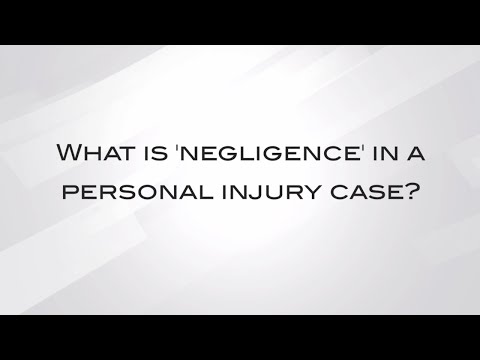

Understanding Negligence Law for Personal Injury: A Comprehensive Overview
Welcome to this informative article on understanding negligence law for personal injury. In this comprehensive overview, we will delve into the fundamental concepts of negligence law in the United States. It is important to note that while this article aims to provide a clear and detailed explanation, it is always advisable to consult multiple sources or seek the advice of a legal professional.
📋 Content in this article
What is Negligence Law?
Negligence law forms the basis for personal injury claims in the United States. It revolves around the idea that individuals have a duty to act reasonably and responsibly towards others, and failing to do so can result in legal consequences if harm occurs as a result.
The Elements of Negligence
To establish a successful negligence claim, the plaintiff (the injured party) must prove four essential elements:
1. Duty of Care: The defendant (the party being sued) must owe a duty of care to the plaintiff. This means that the defendant had a legal obligation to act reasonably and responsibly towards the plaintiff.
2. Breach of Duty: The plaintiff must demonstrate that the defendant breached their duty of care. This typically involves showing that the defendant’s actions or omissions fell below the standard of care expected in a similar situation.
3. Causation: The plaintiff must establish a causal link between the defendant’s breach of duty and the harm suffered. In other words, it must be shown that the defendant’s actions or omissions directly caused the plaintiff’s injuries.
4. Damages: Finally, the plaintiff must prove that they suffered actual damages as a result of the defendant’s negligence. These damages can include physical injuries, emotional distress, financial losses, and other harm that can be compensated.
Comparative Negligence
In some personal injury cases, both the plaintiff and the defendant may share some degree of fault.
Understanding the Essential Elements of Negligence in Personal Injury Cases
Understanding Negligence Law for Personal Injury: A Comprehensive Overview
In the realm of personal injury law, negligence is a fundamental concept that plays a crucial role in determining legal liability and the potential for compensation. Whether you’ve been injured in a car accident, a slip and fall incident, or any other type of accident, understanding the essential elements of negligence is vital in building a strong case. This article aims to provide you with a comprehensive overview of negligence law in the context of personal injury cases.
What is Negligence?
Negligence refers to the failure to exercise reasonable care towards others, resulting in harm or injury. In order to establish a claim of negligence, certain elements must be proven. These elements include:
It is important to note that in negligence cases, the burden of proof rests on the plaintiff.
Understanding Negligence in Personal Injury Cases: A Comprehensive Overview
Understanding Negligence Law for Personal Injury: A Comprehensive Overview
In the realm of personal injury law, understanding negligence is crucial. Negligence refers to a failure to exercise reasonable care, resulting in harm or injury to another person. This concept forms the foundation of many personal injury cases. To navigate this area of law effectively, it is essential to have a comprehensive understanding of negligence and its key components.
The Elements of Negligence
To establish a claim of negligence, the plaintiff (the injured party) must prove four key elements:
Comparative Negligence
It is important to note that negligence can sometimes be shared between multiple parties. In such cases, comparative negligence principles come into play. Comparative negligence allows for a determination of each party’s degree of fault and assigns liability accordingly. Under this system, if the plaintiff is found partially at fault for their injuries, their damages may be reduced in proportion to their degree of fault.
Title: Understanding Negligence Law for Personal Injury: A Comprehensive Overview
Introduction:
Negligence law is a fundamental aspect of the United States legal system, particularly in the context of personal injury cases. It establishes the standard of care that individuals must uphold to avoid causing harm to others. As an expert in US law, I aim to provide a thorough understanding of negligence law to empower readers with knowledge on this critical topic.
Importance of Staying Current:
Staying current on negligence law is of utmost importance due to its far-reaching implications in personal injury cases. The legal landscape is ever-evolving, with new precedents being set and statutes being amended regularly. Therefore, remaining informed on the latest developments ensures that individuals involved in personal injury cases can effectively navigate the legal process.
Verifying and Cross-Referencing:
It is crucial to emphasize that while this article intends to provide a comprehensive overview of negligence law, readers should always verify and cross-reference the content with official legal sources. This article serves as a starting point for understanding negligence law but should not be considered a substitute for professional legal advice.
Understanding Negligence Law:
1. Definition of Negligence:
– Negligence refers to the failure of an individual to take reasonable care, resulting in harm or injury to another person.
– Four elements must be established to prove negligence:
– Duty: The defendant owed a duty of care to the plaintiff.
– Breach: The defendant breached their duty by failing to exercise reasonable care.
– Causation: The defendant’s breach directly caused harm or injury to the plaintiff.
– Damages: The plaintiff suffered actual damages as a result of the defendant’s negligence.
2. Standard of Care:
– The standard of care represents the level of caution and diligence that a responsible person would exercise in similar circumstances.
– The standard varies depending on factors such as age, profession, and the nature of the relationship between the parties involved.
3.
